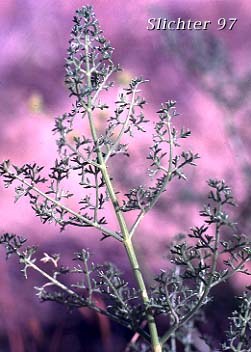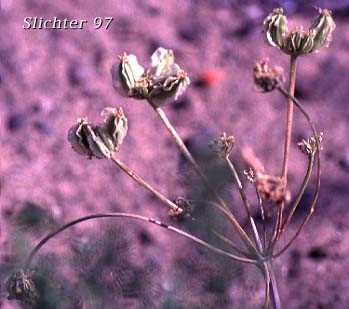 Leaf of northern Indian
parsnip at right........May 5. 1997.
Leaf of northern Indian
parsnip at right........May 5. 1997.
Northern Indian parsnip is a pleasantly aromatic perennial wildflower with one to several ascending stems from 10-60 cm high. The herbage of the leaves and stems is glabrous. The numerous leaves are largely basal with one or more leaves below the middle of the stem. The compound leaves are broadly ovate in outline with blades measuring from 3-18 cm long and from half to nearly as wide as the length. The blades are ternate-pinnately dissected with many small, crowded, long and slender segments oriented in one plane (as opposed to oriented in many planes as in Pungent Desert Parsley Lomatium grayi).
The inflorescence is an umbel with several rays which elongate unequally from 1.5-7 cm long. At flowering, the umbel ranges from 2-7 cm wide. Narrow green bractlets from 2-6 mm long may be found beneath the umbelets. The flowers are yellow while the calyx is greenish. The fruits are ovoid to ovoid-oblong, ranging from 5-11 mm long with the lateral wings about equal to the body or wider, the dorsal wings often as wide as the the lateral. The wings of the fruit are frequently all crisped in this variety as seen in the photo below.
Variety foenicaulaceus: Plants of the foothills to moderate elevation in the mountains and often found in dry, open and rocky places. The inflorescence during flowering is 1-3 cm wide. The segments of the leaves are relatively long and slender. The wings of the fruits are rarely if at all crisped. The dorsal wings are narrower than the broader lateral wings that are now wider than the body. Found from the Blue Mts. of northeastern and central Oregon and southeastern Washington east across the Snake River Plains of central Oregon to western Montana.
Variety terebinthinus: Plants of low elevation, found frequently on open, sandy areas. The inflorescence during flowering is 3-7 cm wide. The segments of the leaves are relatively short and broad. The wings of the fruits are fairly strongly crisped. All the wings are similar and equal to or often broader than the body. Found on the Columbia Plateau of Washington and northern Oregon.
Northern Indian parsnip is found on sand dunes or occasionally in rocky areas.
Northern Indian parsnip is found on the Columbia Plateau of Washington, northeastern Oregon, and the Columbia River Gorge, typically at low elevations.

